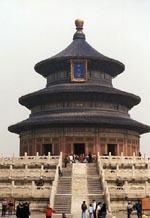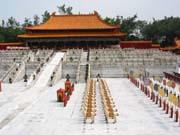

The president of the European Union Commission, Jose
Barroso, has just completed a visit to China, which this
year celebrates the 30th anniversary of the
establishment of diplomatic relations with Brussels.
"Fifteen to 20 years from now the EU, enlarged further
eastwards, more integrated and more independent, might
prove to be the model for the governance of
macro-regions, paving the way for a global political
architecture that can cope with technological, economic
and business globalization.

In the post-Cold-War world, the relationship between
Europe and China has gained momentum. However, as the
world dramatically changed for a second time in a decade
in the fall of 2001, Beijing, a model for developing
countries (paving the way to poverty reduction), and
Brussels, a model for cooperation between countries
(paving the way to articulate sovereignty and
globalization), have to take greater responsibilities to
work as the main architects of a cooperative Eurasia.
In the post-September 11 world disorder, the EU and
China have to conceive a genuine strategy to act as
Eurasia's structuring poles, making them into the
pillars, with the US, of a stable world order.

To face the challenges of this "grand chessboard",
Brussels and Beijing have to agree on a grand strategy.
They have both the material and cultural resources to
become sources of stability for our dangerous and
volatile "global village".
Fundamentally, this will require a common foreign and
security policy reflecting a united and independent
Europe and conducted by a far-sighted strategist. In a
move whose consequences in scope could be compared to
Henry Kissinger's "triangulation", which restructured
the strategic landscape, the EU would decide to
massively support China's economic development, to
invest in trans-continental infrastructure projects -
road, rail, energy, telecommunication, water management,
and to lift the arms embargo on China.


With the handover of Hong Kong (1997) and Macau (1999) ,
there are no more substantial disputes between China and
Europe. In the process of globalization, trade is
booming between a more independent and assertive EU and
an opening China. Both Brussels and Beijing have
clarified their intentions in official documents.
Beijing made an historic move: China in October 2003
released its first-ever policy paper on the EU.

An enlarged Europe is coming closer to an open China,
while Russia is creating the objective conditions to act
as a genuine and constructive bridge. In the 17th
century, German philosopher, physicist and mathematician
Gottfried Leibniz already saw the potential
complementarities between Europe, Russia and China -
Novissima Sinica, but today growing interdependence on
the Eurasian crescent is a reality.
The attitude of Central Eurasia's rising power,
Kazakhstan, and of a democratic Mongolia - whose
intellectual and political elite understands better than
others Eurasian dimensions - complete also the picture
of a Eurasian arc where a momentum for closer
cooperation is gathering.

It is within that context that China and the EU have to
act as two structuring poles of a cooperative Eurasia.
While the EU is a model for cooperation between
countries, China is a model for developing countries.
They are potentially engines for Eurasia's stability and
development.
Fully aware of this potential, a strongly united Europe
and a post-Maoist China should make refocused use of the
Organization for Security and Cooperation in Europe
(after Japan, Korea, Thailand and Afghanistan, China
should become a "partner for cooperation"); the Shanghai
Cooperation Organization (the EU should become at least
an observer); and the Asia-Europe Meeting (needs as soon
as possible to include Mongolia and Kazakhstan).

Brussels and Beijing have to show by their vision and
concrete actions that Eurasia has become genuinely
post-imperial and that under the driving force of their
common strategy they can become, with the US, pillars of
a stable world order.
Reflecting on the relationship between Europe and China,
it is ultimately necessary to take a real measure of
their unique historical-philosophical contexts and to
use these "invisible" factors to ensure the "visible"
interactions. "
end of quotes
Click the title to access the entire article
No comments:
Post a Comment
Be nice and informative when you post or comment.
Thank you to visit Asian Gazette Blog of Joel Legendre-Koizumi.